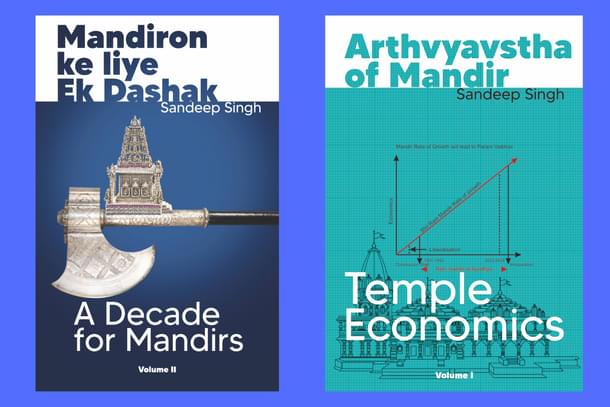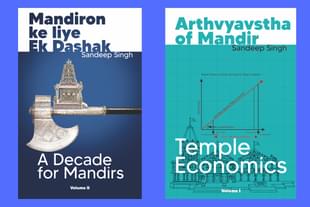Books
The Battle For Bharat's Temples: Two Books To Provide A Framework
Abhijit Phadnis
Jun 16, 2024, 06:28 PM | Updated 06:35 PM IST
Save & read from anywhere!
Bookmark stories for easy access on any device or the Swarajya app.


Bharat is rising in the global arena once again. A lot of its ancient wisdom is coming back to the global stage, thanks to the information age. The centres of this wisdom tradition, the maths and mandirs, have been under constant attack over the last millennium.
This pair of books by Sandeep Singh deals with this important issue, and his hard work and research must be lauded as an important step, among others, to bring back the glory of mandir-based Dharma order. It is not just in the interest of Bharat but the entire world. Dharma unites while religions are dividing people and creating chaos the world over.
Diversity is the nature of the universe. Going against this very nature are creeds, ideologies and philosophies which advocate that only one way is acceptable. Everything else is to be abhorred at the least and destroyed at the earliest opportunity. The world has been held hostage to this kind of thinking for almost two millennia now. Cultures which celebrate diversity, openness and exploration have been at a receiving end from aggressive ideologies which have a narrow worldview of truth, with which they wish to judge everyone and everything else.
One’s way of worship should be a matter of personal choice and its diversity a matter of celebration. Instead, the biggest bloodbaths have happened in the name of religions, calling other cultures’ worship as satanic, heathenish and what have you. Their no-hold-barred onslaughts took many ancient cultures by surprise and many just got destroyed in a matter of decades.
But, despite the waves of religious attacks on the ocean of Dharma, the Bharatiya Sanskruti is resplendent as ever and in fact, over the last decade, thanks to the information age fast emerging as the beacon of hope for this world, getting tired of the religious divide. But, the cost that it has incurred is enormous.
The last millennium for Bharat is a saga of its temples attacked and destroyed by Muslim and Christian invaders, brutal killings of innumerable human beings, rampant conversions on death threats, unbearable taxes, deception, and worst, the deepest suffering of womanhood. The memories of this pain are still echoing in the vast universe and have been stored in the capsule of time.
It was hoped that at least after the 1947 bloody partition, demanded based on Islam, Dharma would be allowed to reclaim its rightful space in at least the ancient nation of its origin. Instead, Dharma was equated with religions and a narrative of secularism was cooked up to cover up the unparalleled human catastrophe in world history, that transpired in this holy land.
A dishonest intellectual onslaught was opened to further take away Dharma’s rightful place from public life. Where the British left, the leftists took over and they wove narratives to further demean Dharma and from academics to cinema used every weapon to do so. They partnered with the very same ideologies which considered Bharat to be an unfinished agenda of their aggression and provided deceptive intellectual cover-fire to build their narratives. Even today, the temples are held hostage by state control and not allowed to reclaim their rightful place as energy centres of Dharmic traditions and thus, the society.
Sandeep Singh’s pair of books ‘Arthavyavastha of Mandir’ (Temple Economics) and ‘Mandiron ke liye Ek Dashak’ (A Decade for Mandirs) captures this saga of pain, desecration, and destruction of temples in great detail.
The aggressors who were brutal in action, were boastful in chronicling their own religious outlook and agenda and provided enough material to trace their intentions and worldview. Sandeep has given references to these in great detail. He has given references to their modern torch bearers too, from the academic arena to activism to the political spectrum, who have demonstrated great intellectual dishonesty to obfuscate the obvious intentions of the aggressors. It is obvious that they have been made to forget the pain their own forefathers were put to by the very ideologies that they are trying to defend today.
It must be admitted that the political and social discourse dominated by the leftists was quite successful for they almost made all Hindus believe that this aggression was purely for economic reasons and had nothing to do with any religious ideology or worldview. They were also almost successful in creating guilt in the minds of Hindus to even remotely claim anything from the past. Some of them have gone thus far as to state that the aggressors wanted to get rid of the wrongdoings happening in the temples!
In all this darkness, Hindus have kept their fight on for their mandirs, their temples. They had done so with great valour in the most difficult days that could be imagined. Sandeep has given examples of how communities and individuals despite the most difficult circumstances around them made every attempt to protect the deities, temples and traditions. Deities were moved, hidden in wells, hidden deep down. What made this Sanskruti distinct that it still could survive these incessant onslaughts? It was of course the valour, devotion and supreme sacrifices of countless men and women who gathered strength and fought with every opportunity.
The oral tradition of knowledge transfer protected the ancient wisdom when the temples and gurukuls were trampled upon and their libraries destroyed. But it was not just that. He has given examples of how the Marathas turned the tide by a spate of reconstructions and reclaiming of temples, as soon as they got the opportunity to dominate the Mughals. While Marathas did this on a scale, there were always attempts around the country to reconstruct temples whenever there were opportunities. Somnath Mandir is a wonderful example of that.
As Sandeep has very well explained, the mandirs of the Hindus are not just monuments of grandeur, because of which they need protection and reclaiming. They are not just engineering, sculptural, architectural and acoustic marvels. They are magnets that hold together knowledge and wisdom traditions. They are repositories of art forms, sculpture, dance, and dramas, for the preservation of seeds and flowers. They are built to replicate human physiology and are supposed to heal specific energy centers of the body. The deities are sacred for devotees and the mutual darshan of the deity and the devotee, opens up the channel of bhakti, devotion and ecstasy.
Our maths and mandirs are core to our identity. After independence, the biggest attack was not just on our temples but on the Hindus’ sense of identity and pride. Thankfully, the tide is turning and with the information explosion, Hindus’ amazing temples, the science hidden in them and their profound wisdom symbolism are being presented to the world through YouTube videos of many distinguished researchers, and they are fast becoming a matter of global attraction.
But Mandirs have a very important dimension of economic impact which also needs to be deeply recognised. Sandeep goes into great detail to explain how temples, despite all the challenges of today including their misuse by state governments, are providing sustainable livelihood to scores of people with the least harm to the environment. They are also centres for creating economic empowerment and transfer of wealth. Sandeep provides case studies of many temple towns all around the country, which have flourished for hundreds of years in sharp contrast to many modern cities which have decayed within a generation.
We all know that as nations advance in economic progress, agriculture and industry form a relatively smaller portion of their economy. It is the services sector which is an expression of human creativity and quest that forms the larger portion of the GDP. In the past, the mandirs of Bharat were an economic magnet that contributed to the GDP exactly for this reason and have the potential to do so once again. Political will is critical here for this to happen.
We have seen some exhibitions of that over the last decade, whether in the form of Ram Janmabhoomi, Kashi Vishwanath Corridor, Ujjain Mahakal Corridor, or pilgrimage circuits, but this needs to be accelerated a great deal. Ram Janmabhoomi could provide a model of how large temples could be managed by Hindus, and that can be the harbinger of the removal of state control on temples. This needs to be done with alacrity.
Politics will gets bolstered when there is a groundswell of this awareness, and Sandeep Singh’s pair of books provides a framework for shaping opinion and creating a larger awareness and wider commitment to this cause. While his current pair of books makes a strong case for the same, they must be followed up by material, in the form of shorter books, blogs, shorts, awareness collaterals and YouTube videos to shape this opinion quickly and widely.
Hindus, are not even aware of the life-nurturing wisdom that the Dharmic traditions provide and thus, the battle for temples must be intertwined by kindling the wisdom through the new age media in a way that the battles for temples and battle for reclaiming Dharma in our lives go hand in hand.
I hope that Sandeep’s books become a torchbearer in this grand movement.
Abhijit Phadnis, PhD is a national rank-holder in CA, CMA, CS and CFA (India) programs and a PhD from IIT Bombay. He has a corporate experience of 41 years and learning facilitation experience of 39 years. He now devotes most of his time for learning the wisdom of the Rishis and sharing it with younger generation.





